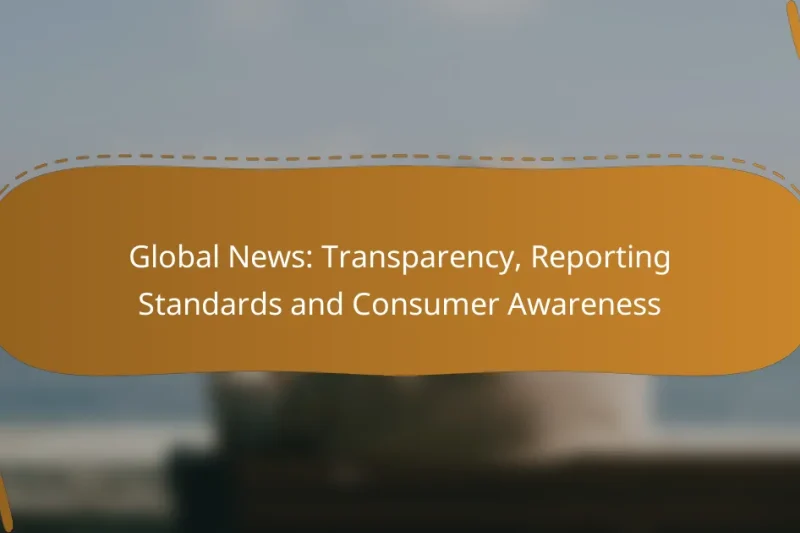In today’s digital age, identifying reliable news sources is essential for consumers seeking accurate information. By … Global News: Reliable Sources, Digital Literacy and Consumer TrustRead more
Trust and Credibility in Global News Reporting
In an era where information is abundant yet often unreliable, trust and credibility in global news reporting are paramount. News organizations can cultivate this trust by emphasizing transparency, accuracy, and ethical standards, while actively engaging with their audiences. By implementing robust fact-checking initiatives and utilizing credible sources, they can significantly enhance their reputation and foster a deeper connection with readers worldwide.
Global News: Ethical Journalism, Audience Trust and Reporting Integrity
In an era where misinformation can spread rapidly, ethical journalism plays a crucial role in fostering … Global News: Ethical Journalism, Audience Trust and Reporting IntegrityRead more
Global News: Transparency, Reporting Standards and Consumer Awareness
In an era where information is abundant, transparency in global news reporting is essential for fostering … Global News: Transparency, Reporting Standards and Consumer AwarenessRead more
Global News: Media Bias, Consumer Perception and Trust
Media bias plays a crucial role in shaping consumer perception and trust in news outlets, particularly … Global News: Media Bias, Consumer Perception and TrustRead more
Global News: User-Generated Content, Credibility and Verification
User-generated content plays a crucial role in enhancing the credibility of global news by offering firsthand … Global News: User-Generated Content, Credibility and VerificationRead more
Global News: Misinformation, Detection Strategies and Reader Awareness
Misinformation in global news poses a significant challenge, distorting public perception and shaping beliefs based on … Global News: Misinformation, Detection Strategies and Reader AwarenessRead more
Global News: Fact-Checking, Public Trust and News Outlets
In an era where misinformation can spread rapidly, fact-checking plays a vital role in enhancing public … Global News: Fact-Checking, Public Trust and News OutletsRead more
How can global news organizations build trust?
Global news organizations can build trust by prioritizing transparency, accuracy, and ethical standards in their reporting. By engaging with audiences and using credible sources, they can foster a reliable reputation that resonates with readers worldwide.
Transparency in reporting
Transparency involves openly sharing the processes behind news reporting, including how information is gathered and verified. News organizations should disclose their sources when possible and explain the context of their reporting to enhance credibility.
For example, a news outlet might provide a detailed account of how a story was developed, including interviews conducted and documents reviewed. This openness allows audiences to understand the depth of research and the basis for the reported facts.
Fact-checking practices
Robust fact-checking is essential for maintaining trust in news reporting. Organizations should implement systematic processes to verify information before publication, utilizing independent fact-checkers when necessary.
Employing a dedicated team for fact-checking can significantly reduce the risk of misinformation. News outlets can also publish corrections promptly when errors are identified, demonstrating accountability and a commitment to accuracy.
Engagement with audiences
Engaging with audiences helps news organizations build a community of trust. This can be achieved through interactive platforms where readers can ask questions, provide feedback, and share their perspectives on news stories.
Utilizing social media channels effectively allows organizations to respond to audience concerns and clarify misunderstandings. Regularly hosting Q&A sessions or forums can further strengthen this relationship.
Use of credible sources
Using credible sources is vital for ensuring the reliability of news reports. Organizations should prioritize information from established experts, official documents, and reputable institutions to support their stories.
When citing sources, it’s beneficial to provide context about their credibility. For instance, referencing a government report or a study from a respected university can enhance the trustworthiness of the information presented.
Adherence to ethical standards
Adhering to ethical standards is crucial for building trust in global news reporting. Organizations should follow established journalistic codes of conduct, which emphasize honesty, fairness, and integrity in reporting.
Training journalists in ethical practices and regularly reviewing compliance can help maintain these standards. Additionally, being transparent about any potential conflicts of interest can further reinforce the organization’s commitment to ethical journalism.
What role does audience engagement play in credibility?
Audience engagement significantly enhances credibility in global news reporting by fostering trust and transparency. When audiences actively participate, they feel more connected to the content, which can lead to a greater perception of reliability and authenticity.
Feedback mechanisms
Feedback mechanisms allow audiences to express their opinions and concerns about news content. This can include comment sections, surveys, or social media interactions. By incorporating audience feedback, news organizations can adjust their reporting to better meet the needs and expectations of their readers.
For instance, a news outlet might analyze feedback trends to identify topics that resonate well or those that require more in-depth coverage. This responsiveness can improve trust and demonstrate that the outlet values its audience’s input.
Interactive content
Interactive content, such as polls, quizzes, and infographics, engages audiences by inviting them to participate actively in the news experience. This type of content not only makes the news more accessible but also encourages users to think critically about the information presented.
For example, a news organization might create an interactive map showing the impact of a global event, allowing users to explore data relevant to their location. This engagement can enhance understanding and retention of the information, further solidifying the outlet’s credibility.
Community involvement
Community involvement plays a crucial role in building credibility by connecting news organizations with local audiences. When news outlets engage with their communities through events, partnerships, or local reporting, they can establish a stronger rapport and trust with their audience.
For instance, a news organization might sponsor local events or collaborate with community leaders to cover issues that matter to residents. This localized approach not only enhances credibility but also ensures that the news reflects the interests and concerns of the community it serves.
How do fact-checking initiatives enhance trust?
Fact-checking initiatives enhance trust in global news reporting by verifying information before it reaches the audience. These efforts help ensure accuracy, reduce misinformation, and build credibility with viewers and readers.
Partnerships with fact-checking organizations
News outlets often collaborate with established fact-checking organizations to validate claims made in their reporting. These partnerships leverage the expertise of fact-checkers, ensuring that information is scrutinized rigorously before publication. For instance, major networks may align with organizations like PolitiFact or FactCheck.org to enhance their credibility.
Such collaborations can also provide a framework for ongoing training and resources, helping journalists develop better fact-checking skills. This proactive approach fosters a culture of accountability within newsrooms.
Real-time fact-checking during broadcasts
Real-time fact-checking during live broadcasts allows news organizations to address misinformation as it occurs. This practice involves having dedicated teams who monitor statements made by speakers and provide immediate corrections or clarifications. For example, during political debates, fact-checkers can quickly verify claims about policies or statistics.
Implementing this strategy not only informs viewers but also demonstrates a commitment to transparency and accuracy. However, it requires significant resources and coordination to execute effectively.
Public access to fact-checking reports
Providing public access to fact-checking reports enhances transparency and allows audiences to verify the information themselves. Many news organizations publish detailed reports that outline the methodology and findings of their fact-checking efforts. This openness encourages trust as audiences can see the rigorous processes behind the claims made in news stories.
Additionally, making these reports easily accessible online can help educate the public about how to discern credible information. News outlets should ensure these resources are user-friendly and widely promoted to maximize their impact.
What are the challenges in maintaining credibility?
Maintaining credibility in global news reporting faces several significant challenges, including information overload, the spread of misinformation, and perceptions of political bias. These factors can undermine trust and make it difficult for audiences to discern reliable sources.
Information overload
Information overload occurs when audiences are bombarded with excessive news content, making it challenging to identify credible sources. This saturation can lead to confusion and fatigue, causing people to disengage from important news topics.
To combat information overload, consumers should prioritize trusted news outlets and utilize tools that curate news based on their interests. Setting specific times to check news can also help manage exposure and maintain focus on quality reporting.
Spread of misinformation
The spread of misinformation is a critical issue in global news, often fueled by social media and unverified sources. False information can quickly gain traction, leading to widespread misconceptions and eroding trust in legitimate news organizations.
To navigate misinformation, individuals should verify facts through multiple reputable sources before accepting them as true. Fact-checking websites can be valuable resources for confirming the accuracy of claims circulating in the media.
Political bias perceptions
Perceptions of political bias can significantly affect how audiences view news credibility. Many people believe that news organizations favor particular political ideologies, which can lead to skepticism about the information presented.
To address political bias perceptions, news consumers should seek diverse viewpoints by engaging with a variety of news sources across the political spectrum. This approach can help develop a more balanced understanding of issues and foster critical thinking about the news consumed.
How can technology improve trust in news reporting?
Technology can enhance trust in news reporting by providing tools for transparency and verification. Innovations like blockchain and AI can help ensure the authenticity of sources and the accuracy of information, fostering greater credibility among audiences.
Blockchain for source verification
Blockchain technology offers a decentralized method for verifying the authenticity of news sources. By creating an immutable record of information, it allows journalists and consumers to trace the origins of a story, ensuring that the information is credible and sourced from reliable entities.
For example, a news organization could use blockchain to log every source and document used in a report. This would enable readers to verify the credibility of the information by accessing the blockchain record, which is transparent and tamper-proof.
When implementing blockchain for source verification, news organizations should consider the costs and technical expertise required. While the benefits of increased trust are significant, the initial investment in technology and training can be substantial. A phased approach, starting with pilot projects, can help mitigate risks and demonstrate value.






